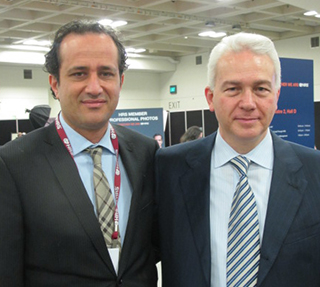
New research indicates that catheter ablation may achieve greater long-term freedom from atrial fibrillation, as well as a reduction in unplanned hospitalisation and mortality in patients with heart failure and persistent atrial fibrillation.
In this open-label, randomised, parallel-group, multicentre clinical trial (AATAC trial), recently published in Circulation, Luigi di Biase (Albert Einstein College of Medicine at Montefiore Hospital, New York, USA and Texas Cardiac Arrhythmia Institute at St Davids Medical Center, Austin, USA) and others set out to assess whether catheter ablation is superior to amiodarone for the treatment of persistent atrial fibrillation in patients with heart failure.
Whilst several catheter ablation trials have demonstrated efficacy in patients without heart failure, the authors of this study were keen to investigate the efficacy in patients with heart failure, given that the “combination of heart failure and atrial fibrillation lead to deleterious haemodynamic and symptomatic consequences.” The authors were driven by the fact that “rhythm control with antiarrhythmic drugs has not shown satisfactory results in randomised trials both in patients with heart failure and without.”
Inclusion criteria comprised patients with persistent atrial fibrillation, dual chamber implantable cardioverter defibrillator or cardiac resynchronisation therapy defibrillator, New York Heart Association class II-III and left ventricular ejection fraction <40% within the last six months. Patients were randomly assigned (1:1) to undergo catheter ablation (group 1, n=102) or to receive amiodarone (group 2, n=101).
They were followed-up for a minimum of 24 months. The primary endpoint was recurrence of atrial fibrillation, atrial flutter or atrial tachycardia
>30 seconds off antiarrhythmic drugs at follow-up. Secondary endpoints included all-cause mortality and unplanned hospitalisation.
The main goal of the ablation procedure was pulmonary vein antrum isolation. Amiodarone therapy was initiated with a loading dose phase followed by a maintenance dose of 200mg per day. However, 27 patients (12 in ablation group and 15 in amiodarone group) receiving low-dose amiodarone (<200 mg/day) were also included in the study.
The trial was divided into a treatment period (the first three months post enrolment or post procedure, which could include repeat ablation, cardioversion or amiodarone titration) followed by the trial period. The trial period started at the end of the treatment period and continued for 24 months.
The primary endpoint was substantially lower for catheter ablation compared to amiodarone (70% vs. 34%, p<0.001) over the two-year follow-up period. The ablation group also had lower mortality (8% vs. 18%, p=0.037). Patients receiving amiodarone were found to be significantly more likely to fail (hazard ratio 2.5 [95% CI 1.5 to 4.3], p<0.001) compared to those undergoing ablation. Unplanned hospitalisation rate was 31% in group 1 and 57% in group 2, p<0.001), showing a 45% relative risk (RR) reduction (RR 0.55, 95% CI 0.39-0.76).
Di Biase notes that in the 102 patients undergoing catheter ablation, a strategy including pulmonary vein isolation plus posterior wall plus non-pulmonary vein trigger ablation was performed in 80 patients while pulmonary vein isolation alone was performed in the remaining 22 patients. Patients undergoing pulmonary vein isolation plus non-pulmonary vein triggers ablation (78.8%) had a higher success rate than patients undergoing pulmonary vein isolation alone (36.4%). At 26±8 months follow-up, the success rates in patients receiving pulmonary vein isolation, pulmonary vein isolation plus posterior wall plus non-pulmonary vein, and amiodarone groups were 8 [36.4%] and 63 [78.8%] and 34 (34.0%) respectively, p<0.001. The outcome in the pulmonary vein alone group was not different from the amiodarone group (p=0.67). In addition, seven (10.4%) patients in the amiodarone group failed after amiodarone discontinuation due to adverse side effects, four had thyroid toxicity, two pulmonary toxicity and one patient developed liver dysfunction.
Andrea Natale (Texas Cardiac Arrhythmia Institute at St David’s Medical Center, Austin, USA) principal investigator and senior author of the paper, deduces from these findings that “ablation improved quality of life and exercise capacity and reduced unplanned hospitalisation and overall mortality.” He continues: “these findings are clinically relevant especially in light of the socio-economic advantages that arise from the reduced re-hospitalisation and mortality in heart failure patients.”
Di Biase told Cardiac Rhythm News that “the results of the trial clearly showed that being in sinus rhythm is key in these patients. A strategy including ablation of pulmonary veins plus non-pulmonary vein triggers is more effective than pulmonary vein isolation alone or treatment with only amiodarone. Amiodarone is the most common drug utilised in these patients; however, it is associated with major side effects, as evidenced by this trial.”
An accompanying editorial by Bruce Koplan (Cardiovascular Division, Brigham and Women’s Hospital, Boston, USA) and others, also published in Circulation, agrees with the main findings by di Biase et al. They note a particular strength of the study being the inclusion of patients with implantable defibrillators that incorporate an atrial lead for detection of recurrent atrial arrhythmias. However, Koplan et al question the applicability of these results to the wider population, owing to “unavoidable biases encountered in recruiting heart failure patients for a trial involving an interventional procedure.” They continue that “a bias toward recruiting ‘healthier’ patients felt likely to tolerate the procedure would be expected, not only for this trial, but other reports of catheter ablation in heart failure patients.” The findings could also not be applied to patients with significantly longer durations of atrial fibrillation, as ablation success rate declines with increased duration. Another potential cause of bias is the presence of pre-enrolment amiodarone therapy in a little more than 10% of the cohort. As is common in many clinical studies, the procedures were performed by experts in ablation, which can impact efficacy and risks. Therefore, extrapolation of the results should be performed with caution.












